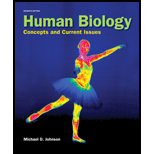
HUMAN BIOLOGY:CONC.+CURRENT..(LOOSE)
7th Edition
ISBN: 9780321862525
Author: Johnson
Publisher: PEARSON
expand_more
expand_more
format_list_bulleted
Question
Chapter 21, Problem 2AWK
Summary Introduction
To review:
The way by which the conjoined twins are formed during the early stages of development.
Introduction:
Twins can be defined as the multiple births that are estimated to occurs once in 90 births. There are rare cases of sextuplets or septuplets (six or seven newborns at once), which occur as result of fertility drugs usage. The occurrence of natural triplets is also rare, that is, 1 in 8,000 births.
Expert Solution & Answer
Want to see the full answer?
Check out a sample textbook solution
Students have asked these similar questions
What is the structure and function of Eukaryotic cells, including their organelles? How are Eukaryotic cells different than Prokaryotic cells, in terms of evolution which form of the cell might have came first? How do Eukaryotic cells become malignant (cancerous)?
What are the roles of DNA and proteins inside of the cell? What are the building blocks or molecular components of the DNA and proteins? How are proteins produced within the cell? What connection is there between DNA, proteins, and the cell cycle? What is the relationship between DNA, proteins, and Cancer?
Why cells go through various types of cell division and how eukaryotic cells control cell growth through the cell cycle control system?
Chapter 21 Solutions
HUMAN BIOLOGY:CONC.+CURRENT..(LOOSE)
Ch. 21 - Prob. 1QCCh. 21 - Prob. 2QCCh. 21 -
1. Why does only one sperm fertilize the egg, and...Ch. 21 - Prob. 2CRCh. 21 - Prob. 3CRCh. 21 - Describe the stages of labor and delivery.Ch. 21 - What causes the newborn to take its first breath...Ch. 21 - Prob. 6CRCh. 21 - What causes the onset of puberty (sexual...Ch. 21 - Summarize the three main hypotheses of the causes...
Ch. 21 - Prob. 9CRCh. 21 - Prob. 10CRCh. 21 - Which of the following lists the correct order of...Ch. 21 - Which of the following will result in fraternal...Ch. 21 -
3. Which of the following processes is the first...Ch. 21 - Prob. 4TYCh. 21 - Prob. 5TYCh. 21 - Prob. 6TYCh. 21 -
7. Which of the following is mismatched?
a....Ch. 21 - Prob. 8TYCh. 21 - Prob. 9TYCh. 21 -
10. Which of the following would be detrimental...Ch. 21 - Prob. 11TYCh. 21 - Prob. 12TYCh. 21 - Prob. 13TYCh. 21 - Prob. 14TYCh. 21 - Which hormone plays a critical role both in...Ch. 21 - Prob. 1AWKCh. 21 - Prob. 2AWKCh. 21 - Prob. 3AWKCh. 21 - Each year, it is estimated that over 40,000...Ch. 21 - Prob. 5AWKCh. 21 - Prob. 6AWKCh. 21 - How is it possible that one's life could be...
Knowledge Booster
Learn more about
Need a deep-dive on the concept behind this application? Look no further. Learn more about this topic, biology and related others by exploring similar questions and additional content below.Similar questions
- In one paragraph show how atoms and they're structure are related to the structure of dna and proteins. Talk about what atoms are. what they're made of, why chemical bonding is important to DNA?arrow_forwardWhat are the structure and properties of atoms and chemical bonds (especially how they relate to DNA and proteins).arrow_forwardThe Sentinel Cell: Nature’s Answer to Cancer?arrow_forward
- Molecular Biology Question You are working to characterize a novel protein in mice. Analysis shows that high levels of the primary transcript that codes for this protein are found in tissue from the brain, muscle, liver, and pancreas. However, an antibody that recognizes the C-terminal portion of the protein indicates that the protein is present in brain, muscle, and liver, but not in the pancreas. What is the most likely explanation for this result?arrow_forwardMolecular Biology Explain/discuss how “slow stop” and “quick/fast stop” mutants wereused to identify different protein involved in DNA replication in E. coli.arrow_forwardMolecular Biology Question A gene that codes for a protein was removed from a eukaryotic cell and inserted into a prokaryotic cell. Although the gene was successfully transcribed and translated, it produced a different protein than it produced in the eukaryotic cell. What is the most likely explanation?arrow_forward
- Molecular Biology LIST three characteristics of origins of replicationarrow_forwardMolecular Biology Question Please help. Thank you For E coli DNA polymerase III, give the structure and function of the b-clamp sub-complex. Describe how the structure of this sub-complex is important for it’s function.arrow_forwardMolecular Biology LIST three characteristics of DNA Polymerasesarrow_forward
arrow_back_ios
SEE MORE QUESTIONS
arrow_forward_ios
Recommended textbooks for you
 Biology (MindTap Course List)BiologyISBN:9781337392938Author:Eldra Solomon, Charles Martin, Diana W. Martin, Linda R. BergPublisher:Cengage Learning
Biology (MindTap Course List)BiologyISBN:9781337392938Author:Eldra Solomon, Charles Martin, Diana W. Martin, Linda R. BergPublisher:Cengage Learning Concepts of BiologyBiologyISBN:9781938168116Author:Samantha Fowler, Rebecca Roush, James WisePublisher:OpenStax College
Concepts of BiologyBiologyISBN:9781938168116Author:Samantha Fowler, Rebecca Roush, James WisePublisher:OpenStax College Human Biology (MindTap Course List)BiologyISBN:9781305112100Author:Cecie Starr, Beverly McMillanPublisher:Cengage Learning
Human Biology (MindTap Course List)BiologyISBN:9781305112100Author:Cecie Starr, Beverly McMillanPublisher:Cengage Learning




Biology (MindTap Course List)
Biology
ISBN:9781337392938
Author:Eldra Solomon, Charles Martin, Diana W. Martin, Linda R. Berg
Publisher:Cengage Learning

Concepts of Biology
Biology
ISBN:9781938168116
Author:Samantha Fowler, Rebecca Roush, James Wise
Publisher:OpenStax College

Human Biology (MindTap Course List)
Biology
ISBN:9781305112100
Author:Cecie Starr, Beverly McMillan
Publisher:Cengage Learning
Embryology | Fertilization, Cleavage, Blastulation; Author: Ninja Nerd;https://www.youtube.com/watch?v=8-KF0rnhKTU;License: Standard YouTube License, CC-BY